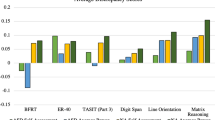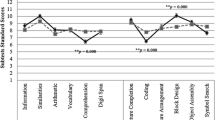Abstract
Compared the motor impairment levels of Asperger syndrome and high functioning autistic children using a standardized test, the Test of Motor Impairment-Henderson Revision. The two groups did not differ on either total or subscale impairment scores. Intelligence level was negatively correlated with motor impairment although the relationship was mostly accounted for by the Asperger children. There was considerable variability within both clinical groups but 50% of Asperger children and 67% of autistic children showed a clinically significant level of motor impairment. Results offer no support for clumsiness as a diagnostically differentiating feature of these disorders.
Similar content being viewed by others
References
American Psychiatric Association. (1987).Diagnostic and statistical manual of mental disorders (3rd ed., rev.). Washington, DC: Author.
Bruninks, R. H. (1974). Physical and motor development of retarded persons. In N. R. Ellis (Ed.),International review of research in mental retardation. New York: Academic Press.
Burgoine, E., & Wing, L. (1983). Identical triplets with Asperger's syndrome.British Journal of Psychiatry, 143, 261–265.
Cox, A. D. (1991). Is Asperger's syndrome a useful diagnosis?Archives of Disease in Childhood, 66, 259–262.
DeMyer, M., Hingtgen, J., & Jackson, R. (1981). Infantile autism reviewed: A decade of research.Schizophrenia Bulletin, 7, 388–451.
Eisenmajer, R., & Prior, M. (1991). An investigation into the cognitive-linguistic correlates of theory of mind in autistic children.British Journal of Developmental Psychology, 9, 351–164.
Fairgrieve, E. M. (1989). Alternative means of assessment: A comparison of standardized tests identifying minimal cerebral dysfunction.British Journal of Occupational Therapy, 52, 88–92.
Frith, U. (1991).Autism and Asperger syndrome. Cambridge, UK: Cambridge University Press.
Ghaziuddin, M., Tsai, L. Y., & Ghaziuddin, N. (1992). Brief report: A reappraisal of clumsiness as a diagnostic feature of Asperger Syndrome.Journal of Autism and Developmental Disorders, 22, 651–656.
Gillberg, C. (1992). The Emanuel Miller Memorial Lecture 1991: Autism and autistic-like conditions: Subclasses among disorders of empathy.Journal of Psychology and Psychiatry, 33, 813–842.
Jones, V., & Prior, M. (1985). Motor imitation abilities and neurological signs in autistic children.Journal of Autism and Developmental Disorders, 15, 37–46.
Lam, Y., & Henderson, S. E. (1987). Some applications of the Henderson Revision of the Test of Motor Impairment.British Journal of Educational Psychology, 57, 389–400.
Mawson, D., Grounds, A., & Tantam, D. (1985). Violence and Asperger's syndrome: A case study.British Journal of Psychiatry, 147, 566–569.
Ozonoff, S., Pennington, B. F., & Rogers, S. J. (1991). Executive function deficits in highfunctioning autistic individuals: Relationship to theory of mind.Journal of Child Psychology and Psychiatry, 32, 1081–1105.
Ozonoff, S., Rogers, S. J., & Pennington, B. F. (1991). Asperger's syndrome: Evidence of an empirical distinction from high-functioning autism.Journal of Child Psychology and Psychiatry, 32, 1107–1122.
Perkins, M., & Wolkind, S. N. (1991). Asperger's syndrome: Who is being abused?Archives of Disease in Childhood, 66, 693–695.
Riggen, K. J., Ulrich, D. A., & Ozmun, J. C. (1990). Reliability and concurrent validity of the Test of Motor Impairment-Henderson Revision.Adapted Physical Activity Quaterly, 7, 249–258.
Spreen, O., & Strauss, E. (1991).A compendium of neuropsychological tests. New York: Oxford University. Press.
Stott, D. H., Moyes, F. A., & Henderson, S. E. (1984).Manual: Test of Motor Impairment (Henderson Revision). Guelph: Brook International.
Stott, D. H., Henderson, S. E., & Moyes, F. A. (1986). The Henderson Revision of the Test of Motor Impairment: A comprehensive approach to assessment.Adapted Physical Activity Quarterly, 3, 204–216.
Szatmari, P., Bartolucci, G., & Bremner, R. (1989). Asperger's syndrome and autism: Comparison of early history and outcome.Developmental Medicine and Child Neurology, 31, 709–720.
Szatmari, P., Tuff, L., Finlayson, A. J., & Bartolucci, G. (1990). Asperger's syndrome and autism: Neurocognitive aspects.Journal of the American Academy of Child and Adolescent Psychiatry, 29, 130–136.
Sugden, D., & Wann, C. (1987). The assessment of motor impairment in children with moderate learning difficulties.British Journal of Educational Psychology, 57, 225–236.
Tantam, D. (1988a). Annotation: Asperger's syndrome.Journal of Psychology and Psychiatry, 29, 245–255.
Tantam, D. (1988b). Lifelong eccentricity and social isolation 11: Asperger's syndrome of schizoid personality disorder?British Journal of Psychiatry, 153, 783–791.
Wall, A. E. (1982). Physically awkward children: A motor development perspective. In J. P. Das, R. F. Mulcahy, & A. E. Wall (Eds.),Theory and research in learning disabilities (pp. 253–268). xxx, xxx.
Wechsler, D. (1974).Manual for the Wechsler Intelligence Scale for Children—Revised. New York: Psychological Corp.
Wechsler, D. (1981).Manual for the Wechsler Adult Intelligence Scale—Revised. New York: Psychological Corp.
Wing, L. (1981). Asperger's syndrome: A clinical account.Psychological Medicine, 11, 115–129.
World Health Organization. (1992).ICD-10. International statistical classification of diseases and related health problems (10th rev.). Geneva: Author.
Author information
Authors and Affiliations
Rights and permissions
About this article
Cite this article
Manjiviona, J., Prior, M. Comparison of Asperger syndrome and high-functioning autistic children on a Test of Motor Impairment. J Autism Dev Disord 25, 23–39 (1995). https://doi.org/10.1007/BF02178165
Issue Date:
DOI: https://doi.org/10.1007/BF02178165




